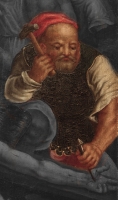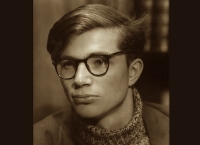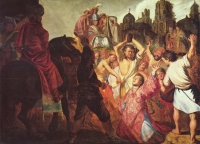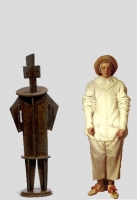21 May 2017
Art’s Timelessness
One of the exciting changes that can happen to you with an EPPH perspective is to discover that we all have the ability to see links between very different images. And the ways we do that are so far removed from conventional understanding that the
05 Dec 2014 | 2 Comments
As in Painting, so is Poetry
The image above, a detail of a painting by Balthus called The Painter and His Model, goes particularly well with the poem below by James Merrill. Balthus, his head wrapped in a cloth to keep paint off his hair, seemingly pulls the curtain aside
02 Dec 2014
How Portraiture Causes Blindness
Specialisation has crippled art history, blinding its practitioners to what is common. For over six years EPPH has been arguing that many portraits by major artists are fusions of the artist's facial features with the sitter's. They were never i
17 Oct 2014
Brushing up on the Painter’s Sword
The mind of an artist is poetic so, if you want to understand painting and sculpture, read poets. Their literary metaphors are the artist’s visual ones. However, beware: poets understand visual art no better than most people. Emile Zola, Charl
20 Aug 2014
The Craftsman’s Christ
This is a scene by an unknown 16th-century artist, probably Flemish, at a time when artisanal effort was admired not just for the perfection of the end-product but for the artisan’s closely-guarded knowledge of materials. Wood, stone, minerals,
28 Jul 2014 | 4 Comments
Ego’s Poetic Powers
EPPH has long argued that artists mute their ego to gain access to poetic depths. Yet in the passage below Colin Wilson, the English philosopher and novelist who died last year, describes a more balanced understanding in which poets identify wit
16 Feb 2014
Is Stoning Stephen Grinding Colors?
In the wider world of art history where the word "art" has not been properly defined, the search for meaning is more complex and difficult than it is here. If biologists studied different types of trees without agreeing on what a tree was, they to
10 Feb 2014
The Poet’s Eye
What you see may not be all you see because somewhere inside most true artworks one form is laid over another. Here's a simple example from a print made by Robert Motherwell (1915-1991), a leader of the New York School in the mid-twentieth century
04 Nov 2013
Do artists still keep secrets?
Is there, as EPPH proposes, a secret tradition, handed down in virtual silence over many centuries, from one artist to another but which is still completely unknown to art historians? I admit that seems unlikely and though I have revealed it in
31 Oct 2013
A Sioux Story on Creation
Every painter paints himself is not just an expression of a poetic method but an insight into the nature of reality. That’s why it’s so important. You can only see in front of you what you already know or feel inside you. Thus, we too p
14 Oct 2013
The Error of Art History
Yesterday I wrote about how some errors make the world interesting and beautiful. This one does not.
Read the Journals of Ralph Waldo Emerson, who rarely saw great art, and you will learn about it on every page because the truths
28 Sep 2013
How Manet and other artists shoot their paintings
Have you ever shot your mother? Directors shoot movies and nearly everyone has made a snap-shot with a camera but few imagine that artists shoot paintings. In fact they have shot nearly every canvas with a gun in it since the devilish implements
09 Sep 2013 | 2 Comments
Art’s Unknown Frown
Artists frown. Constantly. Why? Charles Darwin considered the corrugator, the muscle which results in a frown, as the most remarkable of the human face because it irresistably conveys the idea of mind.1 And that's why, in my opinion, artists hav
17 Jul 2013 | 1 Comments
Michelangelo Rocks in The Battle of Cascina (1504)
This post explains additional obervations not included in the original article here on Michelangelo’s The Battle of Cascina, a 1504 cartoon for a never-completed mural in the civic heart of Florence. It is one of the most celebrated and influe
05 Jul 2013 | 3 Comments
Art’s Etymology
The successful Germans are not very popular at the moment in France, Italy and Great Britain, all suffering economically. But who do you think understands art better? Well, if language is anything to go by, it's not the Romance languages an
13 Jun 2013
Nature and Us
Great artists may follow dogma out of social etiquette or necessity but they think freely, leading them somewhat paradoxically to a similar conclusion.1 They know in unison, as do poets and other sensitive types, that our minds trick us into thi
09 Mar 2013
Proust’s and Degas’ Disappearing Models
Literature and its methods are a useful yardstick by which to judge our knowledge and understanding of the visual arts. For instance, the known fact accepted by literary critics that many friends and acquaintances of Marcel Proust, the great Fre
02 Feb 2013 | 15 Comments
Roy Lichtenstein’s Plagiarism
Plagiarize! Plagiarize! Let no-one else's work evade your eyes! Remember why the good Lord made your eyes, So don't shade your eyes, But plagiarize, plagiarize, plagiarize.....
Tom Lehrer's comical lyrics from the 1950's were pierced
25 Jan 2013 | 3 Comments
Picasso’s Unseen Portrait at the Metropolitan Museum
I was going to write about how the objects most frequently depicted by the Cubists in their café still-lifes – pipe, bottle, glass and guitar – were used not primarily as items characteristic of café-life as Rosalind Kr
01 Dec 2012
Pointing at the Edge
If you cruise the various interpretations on this site, you might have noticed a tendency to explain a figure with an arm or hand pointing to or touching the edge of the image as the artist himself painting a self-portrait. Michael Fried first n
19 Nov 2012
Seeing Through the Artist’s Eyes
Michelangelo's Art Through Michelangelo's Eyes (2005) was my first publication because it demonstrates how important it is to look at poetic art that way, through the eyes of the artist. I have continued to show how the same method works wi
09 Nov 2012
Creation Theology
The painting above by an artist little known outside of Italy, Benedetto Bonfigli, is often titled The Annunciation of the Notaries and is dated to the middle of the fifteenth century. St. Luke who can be seen writing his gospel between the Virg
07 Nov 2012
Jacques Lipchitz as a Jewish Christ
Jacques Lipchitz (1891-1973) was mostly a follower of his period's more innovative artists but that does not mean that he lacked the visual perception to make sense of art. He had that in spades. The bronze, above left, of a Pierrot, a well-
04 Nov 2012
Art and the Human Mind
Rumi was a mystical poet born in what is now Afghanistan in 1207 and died in 1273. The world has learnt little since about being human that Rumi did not already know and his ancestors long before him. Technology and science may be new and
07 Oct 2012 | 7 Comments
Michelangelo’s Skull
In the three-part article on Michelangelo's Art Through Michelangelo's Eyes (2005) I argue that Michelangelo's Last Judgment is a scene inside the artist's mind with many of the figures formed into a giant view of his poetic hero, Dante Alighier
28 Aug 2012
Microbes & Man: The Essence of Art
Who we are, or rather who each artist was, is crucial to our understanding of art in ways that the literature on art rarely, if ever, addresses. Yet once the concept every painter paints himself is seen as central to understanding the artist&rsq
03 May 2012
Art’s Tradition of Secrecy
Great poets are great poets because they have reached heights of spiritual understanding inaccessible to the crowd. The starting-point depends on the individual; some are born prophetic, others somewhere along the way. Those who begin at the bot
01 Apr 2012
Eureka! My Last Judgement on Michelangelo’s
Eureka!
For years I have struggled with the meaning of Michelangelo’s Last Judgment. The essay “Michelangelo’s Art Through Michelangelo’s Eyes” explains my overall understanding of the Sistine ceiling and the altar wall on whi
08 Apr 2011
Art vs. Illustration
Art is not illustration. We all know that. Illustration simply depicts a verbal story and that alone cannot be art. We call those image-makers “illustrators” because they copy reality or a written story. We should not give them the grander t
The EPPH Blog features issues and commentary.




























